ISSN ONLINE(2319-8753)PRINT(2347-6710)
ISSN ONLINE(2319-8753)PRINT(2347-6710)
A.Muniappan1, C.Thiagarajan2, G.ArunKumar2, X.Joseph Raj3, J.Irene4, N.Niranjan5
|
| Related article at Pubmed, Scholar Google |
Visit for more related articles at International Journal of Innovative Research in Science, Engineering and Technology
This paper details about the conversion of conventional car into solar powered electric car. “Energy - Demand” is one of the major threads in our country. Finding solutions, to meet the energy demand is the greatest challenge for Social Scientist, Engineers, Entrepreneurs and Industrialists of our Country. Now-a-days the Concept and Technology employing this renewable energy becomes very popular for all kinds of development activities It’s a proactive approach to shift our source of energy to renewable source. Solar Powered Electric Vehicle which is one of the solutions for the oncoming crisis.
Keywords |
| Solar Energy, Electric Vehicle, Solar Module, Voltage Regulator. |
INTRODUCTION |
| The energy is one of the most vital needs for human survival on earth. The world is currently dependent on fossil fuels for the automobiles. But the main problem of the fossil fuels is that they are not environment friendly and they are exhaustible. So it is necessary to change for the non-conventional sources of energy. In this paper an approach to the conversion of conventional car into solar powered electric car is discussed in detail. |
| The solar vehicle is a step in saving these non renewable sources of energy. The basic principle of solar car is to use energy that is stored in a battery during and after charging it from a solar panel. The charged batteries are used to drive the motor which serves here as an engine and moves the vehicle in reverse or forward direction. This work utilizes a D.C electric motor of 4 kW in the place of Maruthi 800’s engine (Donor car). |
II METHOD & MATERIALS |
| In this project an effort is made to convert the existing conventional vehicle into solar power operated electric vehicle. A used Maruthi 800 car is selected for this project work. The engine of the conventional vehicle is replaced by a 24 V D.C permanent Magnet motor of 4kW.This motor is powered by a 12V, 100 AH lead acid battery. Solar panel is mounted on the roof of the car. Two nos of 120W panel is used to charge the battery. Potentiometeris used as speed controller for varying the vehicle speed. Details of components used for this fabrication is shown in Table1. |
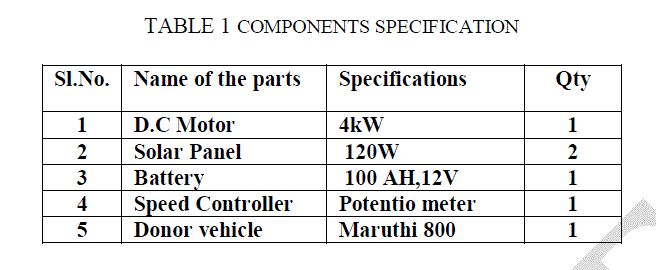 |
HARNESSING POWER FROM SUN |
| The schematic diagram gives an overview of converting solar energy into electrical energy. Energy from Sun is absorbed by the solar panels and which consists these photovoltaic cells converting the solar energy into electrical energy. The electrical charge is consolidated from the PV panel and directed to the output terminals to produce low voltage (Direct Current). The charge controllers direct this power acquired from the solar panel to the batteries. |
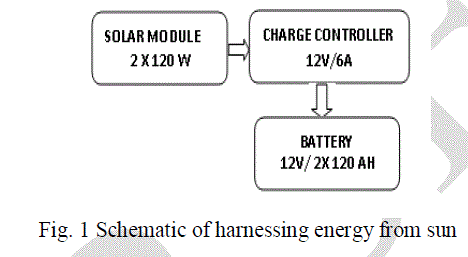 |
SOLAR VEHICLE |
| The below block diagram gives an overview of the working of solar powered electric car. Energy from Sun is absorbed by the solar panels and it is converted into electrical energy. The batteries that get charged by the solar panels. The 24 V DC high torque permanent magnet motor delivers power to vehicle. The shaft of the motor is connected to flywheel of the car through specially designed clutch plate. Through gear box the power is transmitted to front axle. The accelerator of the car is connected with the controller to get different speeds from the motor. |
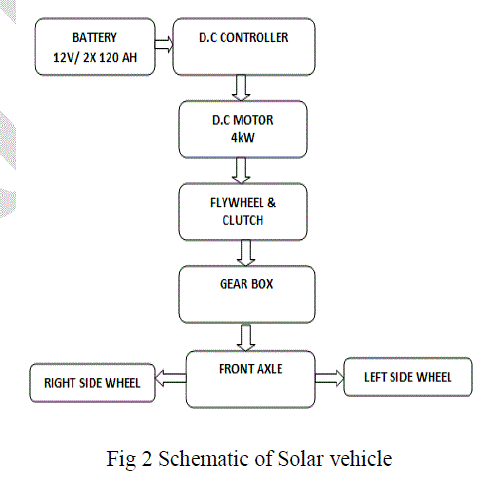 |
III.FABRICATION OF SOLAR CAR |
| A used Maruthi 800 car is donor vehicle for this fabrication. The I.C engine is removed from the car along with radiator. The electric D.C motor, permanent magnet motor of 4 kW isselected for drive. A shaft with bearing is fabricated for connecting the motor with the flywheel of the car. A new clutch plate is also designed for better assembly of flywheel and shaft. The flywheel, gear box, differential and brake of the donor vehicle is retained in the car for same purpose. For varying the speed of the motor, the accelerator is connected with potentiometer. The power from battery goes to motor through potentiometer. Two 12 V & 100 AH Li-ion battery is used for continuous supply of power to motor. Solar panel of 300 Watts are mounted on the roof of the car. The panel can be tilted to follow the sun for better charging of battery. |
SPEED CONTROL SWITCH |
| The speed control of the DC motor is the essential part of the car. Fig 3 shows vehicle power consumption corresponding to its speed. For controlling speed of the motor, a switch was designed with 4 tapping, giving different values of resistance at each tapping, hence limiting the current that flows in the motor. The arrangement of the switch is more or less like a rheostat. The different tapping act as resistance points. With each increase in the tapping value the resistance value decreases, thus at the last tapping the motor will run at the highest speed as the limiting resistance will be minimum. |
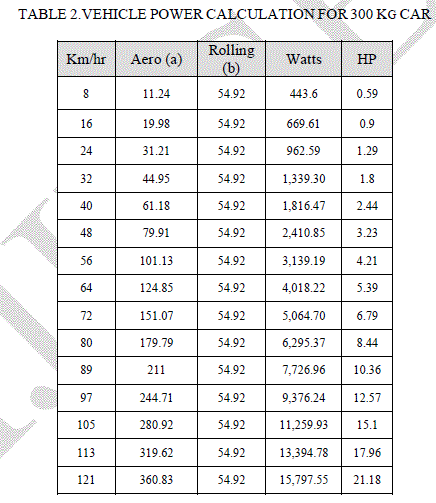 |
| The list of components used with their specification that are required for converting the solar car is given in the following table. |
IV. EXPERIMENTAL DETAILS |
| The solar panel mounted on the top of car is used to charge the batteries through charge controller. A 400 Watts solar panel is used to charge the batteries. The batteries are initially fully charged and then they are connected to solar panel for charging. The solar panel helps to charge during daytime. As the supply is given through potentiometer to motor with help of accelerator, the motor takes a high starting current to propel the wheel to move in forward direction. On the start, the load on motor is nearly 500 kg including the weight of the person driving it. The vehicle reaches the maximum speed of 60kmph. Motor must be started on lowest gear so as to get maximum torque and speed to lift the full load. The speed may be varied later according to the driver’s requirement. For stopping the car, the speed control switch should be brought to minimum gear and then switch should be opened; thereafter the mechanical brakes should be applied. The mechanical brakes can be applied instantly during emergency but this should be avoided as this could damage the motor. |
TEST CONDUCTED |
| The completely charged solar car was tested after the completion of the project. First trail was conducted from Porur to Saveetha University in NH4, the car covered the distance of 17 Km, 46 minutes at the maximum Speed of 65kmph. The second trail was conducted in Chennai city for a distance of 20 km, in which the vehicle took 1 hr with maximum speed of60kmph. |
EXPERIMENTAL RESULTS AND DISCUSSIONS |
1. Speed Vs Power |
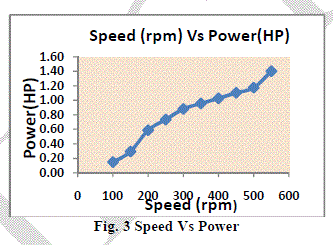 |
| As the speed (wheel rpm) increases the power also increases. From the experimental results, the fig.3 is plotted between the speed and the power and it is evident from the fig.3 that there is direct relationship between them. |
2. Speed Vs Voltage |
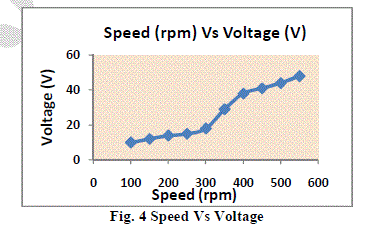 |
| From the experimental results, the graph is plotted between the speed and velocity. The fig.4 shows that the speed is directly proportional to the supply voltage. As the speed increases the velocity also increases. |
3. Vehicle Speed Vs Power |
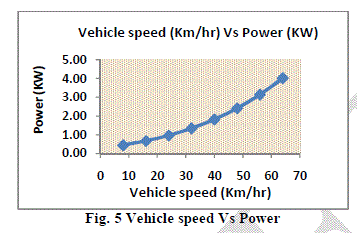 |
| From the experimental results, the graph is plotted between the vehicle speed and power. It is evident from the fig.5 the vehicle speed and power are directly proportional with each other. As the vehicle speed increases the power also increases. |
ADVANTAGES & LIMITATIONS OF THE CAR |
| The solar cars are the future of the automotive industry. They are highly feasible and can be manufactured with ease. The main advantages of solar car are that they are pollution free and are very economical. Since they cause no pollution they are very eco-friendly and are the only answer to the increasing pollution levels from automobiles in the present scenario. By utilizing the renewable sources of energy like the solar energy we are helping in preserving the nonrenewable sources of energy. Normally electric vehicle does not have gear system; this particular vehicle is fabricated with gear system for safety of electric motor & user friendly driving. The speed of the car is limited to 60 kmph. The current batteries are too heavy & it takes long time for charging. So better technology is required for reducing the weight of the battery & minimize the charging time. The cost of the panel is high; it increases the cost of the vehicle. |
V. CONCLUSION |
| Mainly commercial vehicles are for short distance operation in urban conditions. Using a battery to run the vehicle incorporated with solar energy is much cheaper than either petrol or diesel vehicle. The vehicle is pollution free and toxic exhaust that are harmful to earth. The vehicle runs smoothly without noise hence reducing noise pollution. The vehicles thus serves an alternate for soon depleting fossil fuels.This technology is most suitable for energy alternate using devices. The people who wish to travel can accept this proved technology for implementation. Moreover the same technique and technology can also be extended for all types of Automobiles in the transportation sector. |
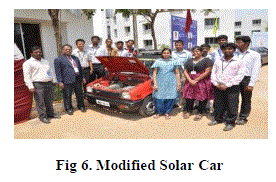 |
References |
|